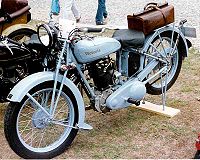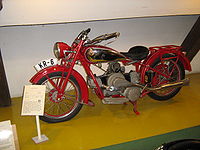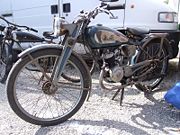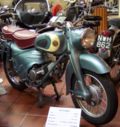
Victoria (motorcycle)
Encyclopedia
Victoria was a bicycle
manufacturer in Nürnberg, Germany
that made motorcycles from about 1901 until 1966. It should not be confused with a lesser-known, unrelated Victoria Motorcycle Company in Glasgow
, Scotland
that made motorcycles between 1902 and 1928.
In its early decades Victoria in Nürnberg fitted proprietary engines purchased from various manufacturers including Fafnir
, FN, Minerva and Zédel
.


 In 1920 Victoria launched the model KR 1, which has a 494 cc BMW
In 1920 Victoria launched the model KR 1, which has a 494 cc BMW
twin-cylinder
side-valve
flat twin
(boxer engine) mounted longitudinally in the motorcycle frame. The engine produced 6.5 bhp and transmission was via a two-speed gearbox
.
When BMW started making its own motorcycles, Victoria turned to making its own engines. In 1923 Victoria launched its KR 2, an overhead valve
(OHV) flat twin producing 9 hp. In 1924 Victoria followed this with the KR 3, which produces 12 hp and has a 3-speed gearbox. In 1925 Victoria built Germany's first forced induction
engine, and in 1926 a 496 cc Victoria achieved a motorcycle Land speed record
of 165 km/h (102.5 MPH). In 1927 Victoria launched the 596 cc KR VI or KR 6. Based on this model the factory offered a high-speed sports model with twin carburettors that produced 24 bhp, later named the KR 7.
At the same time Victoria also offered the 200 cc side-valve KR 20 and 350 cc overhead valve KR 35 models. In 1930/31 it added to its range the KR 50 (side-valve) and KR 50 S (overhead valve) models, which have engines imported from Sturmey-Archer
in England
.
In 1932 Victoria won the sidecar
class of the European Hill Climb Championship
with a 600 cc machine and thereafter offered a model with 20 bhp and a four-speed gearbox as the KR 6 Bergmeister. At the same time it offered the KR 15 and KR 20 Z models with 150 cc and 200 cc two-stroke engines supplied by ILO.
 In 1933 Victoria introduced a 500 cc parallel twin
In 1933 Victoria introduced a 500 cc parallel twin
, the KR 8. This had a side-valve engine with its cylinder block inclined forwards almost horizontally. This placed the valves under the cylinder head, where the exhaust valves suffered from overheating.
In 1934 the National Socialist
government forbade the import of foreign components, which ended Victoria's use of Sturmey-Archer engines.
.jpg) In 1935 Victoria revised the KR 8 engine to the unusual exhaust over inlet (EOI) valve layout, and called the resulting model the KR 9 Fahrmeister. Using EOI on a nearly horizontal engine placed the exhaust valves in cooler air at the front and solved the overheating. Unfortunately it also increased the complexity and cost of manufacture and maintenance. Victoria discontinued the KR 9 after 1935.
In 1935 Victoria revised the KR 8 engine to the unusual exhaust over inlet (EOI) valve layout, and called the resulting model the KR 9 Fahrmeister. Using EOI on a nearly horizontal engine placed the exhaust valves in cooler air at the front and solved the overheating. Unfortunately it also increased the complexity and cost of manufacture and maintenance. Victoria discontinued the KR 9 after 1935.
Also in 1935 Victoria introduced the 350 cc KR 35 B and KR 35 G models with Lackler-patented cylinder heads. In 1937 the first KR 35 Sport was built with a Columbus
engine. In the same year Victoria introduced new KR 20 LN Lux and KR 25 S Aero two-stroke models, whose engines with flat-topped pistons were developed by Richard and Xaver Küchen
. In 1938 Victoria offered the Columbus-engined KR 35 SN (18 bhp) and KR 35 SS (20 bhp) models. At the same time Victoria expanded its range of two-strokes with the lightweight V 99 Fix, V 109 Fix (which was a ladies' version of the V 99 Fix), KR 12-N and KR 15-N.
In 1939 the Second World War almost completely halted production of the KR 35 Pionier, although limited production continued until at least 1942. In 1945 the Victoria factory
's production hall was severely damaged.
.jpg) In 1946 Victoria resumed production with the 38 cc FM 38 bicycle engine
In 1946 Victoria resumed production with the 38 cc FM 38 bicycle engine
. In 1949 the company resumed production of the pre-war KR 25 Aero model. In 1950 Victoria introduced the 99 cc V 99 BL-Fix and modernised the KR 25 Aero with a telescopic front fork. At the same time the company built the models Vicky I and Vicky II using the FM 38 bicycle engine. By the end of the year KR 25 Aero production was 14,000 per year, and from 1951 the model was equipped with Jurisch plunger rear suspension.
 In 1953 Victoria developed its popular model further as the KR 26 Aero, and expanded its range with the new Küchen-designed V 35 Bergmeister. The V 35 is a 350 cc OHV four-stroke V-twin
In 1953 Victoria developed its popular model further as the KR 26 Aero, and expanded its range with the new Küchen-designed V 35 Bergmeister. The V 35 is a 350 cc OHV four-stroke V-twin
producing 21 bhp. The V 35's powertrain
combines chain primary drive to the gearbox with shaft drive to the rear wheel.
In 1955 Victoria introduced the Peggy motor scooter
, which has a 200 cc fan-cooled two-stroke engine and an electric starter
. In the same year the company also offered the technologically advanced - but consequently expensive - KR 21 Swing motorcycle.
In 1957 Victoria launched a new model with a 175 cc OHV four-stroke engine imported from Parilla
in Italy
: the KR 17 Parilla.
In 1958 Victoria merged with DKW
and Express Werke AG
, forming Zweirad Union, which continued the Victoria name for mopeds such as the Vicky and motor scooters. In 1966 Hercules
took over Zweirad Union and terminated Victoria production.
Bicycle
A bicycle, also known as a bike, pushbike or cycle, is a human-powered, pedal-driven, single-track vehicle, having two wheels attached to a frame, one behind the other. A person who rides a bicycle is called a cyclist, or bicyclist....
manufacturer in Nürnberg, Germany
Germany
Germany , officially the Federal Republic of Germany , is a federal parliamentary republic in Europe. The country consists of 16 states while the capital and largest city is Berlin. Germany covers an area of 357,021 km2 and has a largely temperate seasonal climate...
that made motorcycles from about 1901 until 1966. It should not be confused with a lesser-known, unrelated Victoria Motorcycle Company in Glasgow
Glasgow
Glasgow is the largest city in Scotland and third most populous in the United Kingdom. The city is situated on the River Clyde in the country's west central lowlands...
, Scotland
Scotland
Scotland is a country that is part of the United Kingdom. Occupying the northern third of the island of Great Britain, it shares a border with England to the south and is bounded by the North Sea to the east, the Atlantic Ocean to the north and west, and the North Channel and Irish Sea to the...
that made motorcycles between 1902 and 1928.
In its early decades Victoria in Nürnberg fitted proprietary engines purchased from various manufacturers including Fafnir
Fafnir (automobile)
Fafnir was a German engine and vehicle manufacturer based in Aachen. They made a range of cars between 1908 and 1926.The company was founded in 1894 producing needles. With the growth of the bicycle industry, they started to make wheel spokes...
, FN, Minerva and Zédel
Zédel
Zédel was a Swiss automobile manufacturer established in 1901 by Ernest Zürcher and Herman Lüthi. The factory first manufactured motorcycle engines.In 1906, Zedel began producing automobiles . By 1914 about 400 units had been produced....
.
1920–1932



BMW motorcycles
BMW's motorcycle history began in 1921 when the company commenced manufacturing engines for other companies. Motorcycle manufacturing now operates under the BMW Motorrad brand...
twin-cylinder
Cylinder (engine)
A cylinder is the central working part of a reciprocating engine or pump, the space in which a piston travels. Multiple cylinders are commonly arranged side by side in a bank, or engine block, which is typically cast from aluminum or cast iron before receiving precision machine work...
side-valve
Flathead engine
A flathead engine is an internal combustion engine with valves placed in the engine block beside the piston, instead of in the cylinder head, as in an overhead valve engine...
flat twin
Flat engine
A flat engine is an internal combustion engine with multiple pistons that move in a horizontal plane. Typically, the layout has cylinders arranged in two banks on either side of a single crankshaft and is sometimes known as the boxer, or horizontally opposed engine. The concept was patented in 1896...
(boxer engine) mounted longitudinally in the motorcycle frame. The engine produced 6.5 bhp and transmission was via a two-speed gearbox
Transmission (mechanics)
A machine consists of a power source and a power transmission system, which provides controlled application of the power. Merriam-Webster defines transmission as: an assembly of parts including the speed-changing gears and the propeller shaft by which the power is transmitted from an engine to a...
.
When BMW started making its own motorcycles, Victoria turned to making its own engines. In 1923 Victoria launched its KR 2, an overhead valve
Overhead valve
An overhead valve engine, also informally called pushrod engine or I-head engine, is a type of piston engine that places the camshaft within the cylinder block , and uses pushrods or rods to actuate rocker arms above the cylinder...
(OHV) flat twin producing 9 hp. In 1924 Victoria followed this with the KR 3, which produces 12 hp and has a 3-speed gearbox. In 1925 Victoria built Germany's first forced induction
Forced induction
Forced induction is the process of compressing air on the intake of an internal combustion engine . A forced induction engine uses a gas compressor to increase the pressure, temperature and density of the air...
engine, and in 1926 a 496 cc Victoria achieved a motorcycle Land speed record
Land speed record
The land speed record is the highest speed achieved by a wheeled vehicle on land. There is no single body for validation and regulation; in practice the Category C flying start regulations are used, officiated by regional or national organizations under the auspices of the Fédération...
of 165 km/h (102.5 MPH). In 1927 Victoria launched the 596 cc KR VI or KR 6. Based on this model the factory offered a high-speed sports model with twin carburettors that produced 24 bhp, later named the KR 7.
At the same time Victoria also offered the 200 cc side-valve KR 20 and 350 cc overhead valve KR 35 models. In 1930/31 it added to its range the KR 50 (side-valve) and KR 50 S (overhead valve) models, which have engines imported from Sturmey-Archer
Sturmey-Archer
Sturmey-Archer is a manufacturing company originally from Nottingham, England. It primarily produces bicycle hub gears but has also produced motorcycle hubs....
in England
England
England is a country that is part of the United Kingdom. It shares land borders with Scotland to the north and Wales to the west; the Irish Sea is to the north west, the Celtic Sea to the south west, with the North Sea to the east and the English Channel to the south separating it from continental...
.
In 1932 Victoria won the sidecar
Sidecar
A sidecar is a one-wheeled device attached to the side of a motorcycle, scooter, or bicycle, producing a three-wheeled vehicle.-History:A sidecar appeared in a cartoon by George Moore in the January 7, 1903, issue of the British newspaper Motor Cycling. Three weeks later, a provisional patent was...
class of the European Hill Climb Championship
European Hill Climb Championship
The European Hill Climb Championship is an FIA-run motorsport competition held across Europe on mountain roads.Unlike circuit racing, each driver competes alone, starting from a point at the base of a mountain and reaching a finish point near the summit...
with a 600 cc machine and thereafter offered a model with 20 bhp and a four-speed gearbox as the KR 6 Bergmeister. At the same time it offered the KR 15 and KR 20 Z models with 150 cc and 200 cc two-stroke engines supplied by ILO.
1933–1945

Straight-two
A straight-two engine, is a two-cylinder piston engine that has its cylinders arranged side by side....
, the KR 8. This had a side-valve engine with its cylinder block inclined forwards almost horizontally. This placed the valves under the cylinder head, where the exhaust valves suffered from overheating.
In 1934 the National Socialist
National Socialist Party
Parties in various contexts have referred to themselves as National Socialist parties. Because there is no clear definition of national socialism, the term has been used to mean very different things...
government forbade the import of foreign components, which ended Victoria's use of Sturmey-Archer engines.
.jpg)
Also in 1935 Victoria introduced the 350 cc KR 35 B and KR 35 G models with Lackler-patented cylinder heads. In 1937 the first KR 35 Sport was built with a Columbus
Horex
Horex is a German motorcycle manufacturer. It was founded in 1920 by the Rex glassware company, which conflated Homburg and Rex to create the brand name. The headquarter was in Bad Homburg....
engine. In the same year Victoria introduced new KR 20 LN Lux and KR 25 S Aero two-stroke models, whose engines with flat-topped pistons were developed by Richard and Xaver Küchen
Kuchen
Kuchen , the German word for cake, is used in other languages as the name for several different types of sweet desserts, pastries, and gateaux...
. In 1938 Victoria offered the Columbus-engined KR 35 SN (18 bhp) and KR 35 SS (20 bhp) models. At the same time Victoria expanded its range of two-strokes with the lightweight V 99 Fix, V 109 Fix (which was a ladies' version of the V 99 Fix), KR 12-N and KR 15-N.
In 1939 the Second World War almost completely halted production of the KR 35 Pionier, although limited production continued until at least 1942. In 1945 the Victoria factory
Factory
A factory or manufacturing plant is an industrial building where laborers manufacture goods or supervise machines processing one product into another. Most modern factories have large warehouses or warehouse-like facilities that contain heavy equipment used for assembly line production...
's production hall was severely damaged.
1946–1966
.jpg)
Motorized bicycle
A motorized bicycle, motorbike, cyclemotor, or vélomoteur is a bicycle with an attached motor and transmission used either to power the vehicle unassisted, or to assist with pedaling. Since it always retains both pedals and a discrete connected drive for rider-powered propulsion, the motorized...
. In 1949 the company resumed production of the pre-war KR 25 Aero model. In 1950 Victoria introduced the 99 cc V 99 BL-Fix and modernised the KR 25 Aero with a telescopic front fork. At the same time the company built the models Vicky I and Vicky II using the FM 38 bicycle engine. By the end of the year KR 25 Aero production was 14,000 per year, and from 1951 the model was equipped with Jurisch plunger rear suspension.

V-twin
A V-twin engine is a two-cylinder internal combustion engine where the cylinders are arranged in a V configuration.- Crankshaft configuration :Most V-twin engines have a single crankpin, which is shared by both connecting rods...
producing 21 bhp. The V 35's powertrain
Powertrain
In a motor vehicle, the term powertrain or powerplant refers to the group of components that generate power and deliver it to the road surface, water, or air. This includes the engine, transmission, drive shafts, differentials, and the final drive...
combines chain primary drive to the gearbox with shaft drive to the rear wheel.
In 1955 Victoria introduced the Peggy motor scooter
Scooter (motorcycle)
A scooter is a motorcycle with step-through frame and a platform for the operator's feet. Elements of scooter design have been present in some of the earliest motorcycles, and motorcycles identifiable as scooters have been made from 1914 or earlier...
, which has a 200 cc fan-cooled two-stroke engine and an electric starter
Automobile self starter
A starter motor is an electric motor for rotating an internal-combustion engine so as to initiate the engine's operation under its own power.- History :...
. In the same year the company also offered the technologically advanced - but consequently expensive - KR 21 Swing motorcycle.
In 1957 Victoria launched a new model with a 175 cc OHV four-stroke engine imported from Parilla
Parilla
Parilla may refer to:* A brand name belonging to kart engine maker Italian American Motor Engineering, including the 100 cc Parilla Reedjet for use in the ICA class and the 125 cc Leopard TaG....
in Italy
Italy
Italy , officially the Italian Republic languages]] under the European Charter for Regional or Minority Languages. In each of these, Italy's official name is as follows:;;;;;;;;), is a unitary parliamentary republic in South-Central Europe. To the north it borders France, Switzerland, Austria and...
: the KR 17 Parilla.
In 1958 Victoria merged with DKW
DKW
DKW is a historic German car and motorcycle marque. The name derives from Dampf-Kraft-Wagen .In 1916, the Danish engineer Jørgen Skafte Rasmussen founded a factory in Zschopau, Saxony, Germany, to produce steam fittings. In the same year, he attempted to produce a steam-driven car, called the DKW...
and Express Werke AG
Express Werke AG
Express Werke AG was a company in Neumarkt in der Oberpfalz, Germany that manufactured bicycles and motorcycles. In the 1930s Express built mopeds and lightweight motorcycles with 75cc and 98cc Sachs engines. From 1949 the company resumed production using Sachs and ILO engines up to 248cc. In 1958...
, forming Zweirad Union, which continued the Victoria name for mopeds such as the Vicky and motor scooters. In 1966 Hercules
Hercules (motorcycle)
Hercules was a brand of motorcycle manufactured in Germany until 1992.The Hercules Company was founded in 1886 and began producing motorcycles in 1904. It was merged with Zweirad Union after being purchased by ZF Sachs in 1963....
took over Zweirad Union and terminated Victoria production.
External links
- Victoria Owners' Club, including Victoria history (in German and English)
- Victoria-Oldtimer website, including Victoria history (in German)
- Meisterdinger von Nürnberg Victoria webpages (in German)
- Schlauweb website, including Victoria history (in German)
- V35-Bergmeister.com (in German and English)

